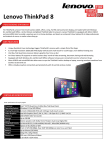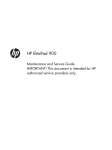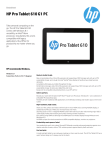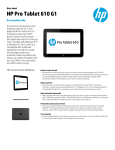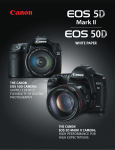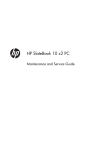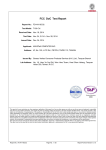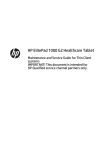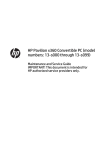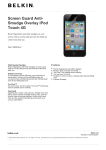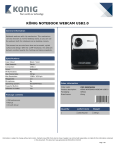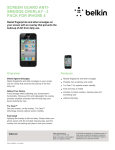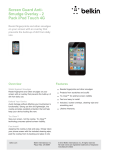Download HP 15c Maintenance and Service Guide
Transcript
HP Pro Tablet 610 and HP Omni10 Maintenance and Service Guide IMPORTANT! This document is intended for HP authorized service providers only. © Copyright 2014 Hewlett-Packard Development Company, L.P. Bluetooth is a trademark owned by its proprietor and used by Hewlett-Packard Company under license. Intel and Core are U.S. registered trademarks of Intel Corporation. Microsoft and Windows are U.S. registered trademarks of Microsoft Corporation. SD Logo is a trademark of its proprietor. The information contained herein is subject to change without notice. The only warranties for HP products and services are set forth in the express warranty statements accompanying such products and services. Nothing herein should be construed as constituting an additional warranty. HP shall not be liable for technical or editorial errors or omissions contained herein. Second Edition: April 2014 First Edition: October 2013 Document Part Number: 737637-002 Product notice This guide describes features that are common to most models. Some features may not be available on your tablet. Not all features are available in all editions of Windows 8. This tablet may require upgraded and/or separately purchased hardware, drivers, and/or software to take full advantage of Windows 8 functionality. See for http://www.microsoft.com details. Software terms By installing, copying, downloading, or otherwise using any software product preinstalled on this tablet, you agree to be bound by the terms of the HP End User License Agreement (EULA). If you do not accept these license terms, your sole remedy is to return the entire unused product (hardware and software) within 14 days for a refund subject to the refund policy of your place of purchase. For any further information or to request a full refund of the tablet, please contact your local point of sale (the seller). Safety warning notice WARNING! To reduce the possibility of heat-related injuries or of overheating the device, do not place the device directly on your lap or obstruct the device air vents. Use the device only on a hard, flat surface. Do not allow another hard surface, such as an adjoining optional printer, or a soft surface, such as pillows or rugs or clothing, to block airflow. Also, do not allow the AC adapter to contact the skin or a soft surface, such as pillows or rugs or clothing, during operation. The device and the AC adapter comply with the user-accessible surface temperature limits defined by the International Standard for Safety of Information Technology Equipment (IEC 60950). iii iv Safety warning notice Table of contents 1 Product description ........................................................................................................... 1 2 External component identification ..................................................................................... 4 Finding your hardware and software information ......................................................................... 4 Locating hardware .................................................................................................... 4 Locating software ....................................................................................... 4 Front ....................................................................................................................................... 5 Back ....................................................................................................................................... 6 Top edge ................................................................................................................................ 7 Back edge ............................................................................................................................... 8 Labels ..................................................................................................................................... 9 3 Illustrated parts catalog .................................................................................................. 10 Locating the serial number, product number, and model number .................................................. 10 Tablet major components ........................................................................................................ 11 Miscellaneous parts ................................................................................................................ 13 Sequential part number listing .................................................................................................. 14 4 Removal and replacement preliminary requirements ...................................................... 16 Tools required ....................................................................................................................... 16 Service considerations ............................................................................................................ 16 Plastic parts ............................................................................................................ 16 Cables and connectors ............................................................................................ 16 Grounding guidelines ............................................................................................................. 17 Electrostatic discharge damage ................................................................................. 17 Packaging and transporting guidelines ....................................................... 18 Workstation guidelines .............................................................. 18 5 Removal and replacement procedures ............................................................................ 20 Back cover ............................................................................................................................ 20 Power button board ................................................................................................................ 22 v Volume button board .............................................................................................................. 23 Front-facing webcamera ......................................................................................................... 25 Light sensor board .................................................................................................................. 27 Rear-facing webcamera .......................................................................................................... 28 Audio board ......................................................................................................................... 30 Vibrator module ..................................................................................................................... 32 Battery .................................................................................................................................. 33 Wireless antennas .................................................................................................................. 35 SIM/card reader board .......................................................................................................... 37 Speakers ............................................................................................................................... 38 Display panel cable ............................................................................................................... 40 System board ........................................................................................................................ 42 6 Using Setup Utility (BIOS) ................................................................................................ 46 Starting Setup Utility (BIOS) ..................................................................................................... 46 Updating the BIOS ................................................................................................................. 46 Determining the BIOS version ................................................................................... 47 Downloading a BIOS update .................................................................................... 47 7 Specifications .................................................................................................................. 49 8 Backing up, restoring, and recovering ............................................................................ 50 Creating a Microsoft recovery drive (select models only) ............................................................. 50 Using Windows Refresh for quick and easy recovery .................................................................. 51 Removing everything and reinstalling Windows ......................................................................... 51 Backing up data using File History ........................................................................................... 52 9 Power cord set requirements .......................................................................................... 53 Requirements for all countries .................................................................................................. 53 Requirements for specific countries and regions ......................................................................... 53 10 Recycling ...................................................................................................................... 55 Index ................................................................................................................................. 56 vi 1 Product description Category Description Product Name HP Pro Tablet 610 HP Pro Tablet 610 × HP Omni10 Processor Intel Quad Core Z3795 1.60-GHz (turbo up to 2.39-GHz) processor HP Omni10 × × Intel Quad Core Z3775 1.46-GHz (turbo up to 2.39-GHz) processor Intel Quad Core Z3770 1.46-GHz (turbo up to 2.40-GHz) processor × Panel 10.1-in, AntiGlare (AG), light-emitting display (LED), WUXGA (1920×1200) , multitouch, capacitive, Gorilla glass 3 TouchScreen (with antismudge and airbonding, Windows 8 compliant); .ultraslim; 16:10 aspect ratio, typical brightness: 400 nits; 18-bit color depth with FRC; ≥80/80/80/80 viewing angle; UWVA Dual-link eDP interface × × Graphics Intel Graphics Media Accelerator × × Support for HD playback, streaming, and recording at 1080p at 30fps Support for DX11 Memory Support for 2048-MB (1024-MB × 2), 8GB at 1600-MHz LPDDR3 128M × 32 × 2 memory IC × × Mass storage Support for embedded MultiMediaCard (eMMC) NAND flash (v4.51) × × Support for 64- or 32-GB eMMC mass storage memory 1 Category Description Audio and video One digital microphone HP Pro Tablet 610 HP Omni10 × × × × × × × × × × × × × × × × Stereo speakers 2.0-MP front-facing webcamera with webcamera activity light 8.0-MP rear-facing webcamera with autofocus Sensors Wireless networking ● Ambient light sensor ● Accelerometer ● eCompass ● Gyro ● Hall-effect sensor Integrated wireless option: Mitsumi DWM-W095A WiFi+BT 4.0 combination module with 2 antenna Bluetooth: Class 1 Bluetooth 4.0+LE Wifi: 802.11a/b/g/n 2×2 multipleinput and multiple-output (MIMO) External expansion Integrated micro SD card, support SDXC in DDR50, SDR25 and SDR12 mode Ports ● Audio: 3.5-mm headphone/ microphone combo jack, support NA type headset only ● HDMI type-D connector ● Power connector ● Micro USB 2.0 type AB connector (support for host mode only) ● Power ● Volume down ● Volume up Keys Power requirements Support for 2-cell, 3.10-WHr, 4.19-AHr, Li-ion battery (non-removable) Support for 18-W (12-V/1.5-A) non-PFC AC adapter with DC plug and localized cable plug support Security 2 Software-based Trusted Platform Module (TPM) solution Chapter 1 Product description Category Description HP Pro Tablet 610 HP Omni10 Operating system Preinstalled: Microsoft Windows 8.1 (32-bit) × × Serviceability End user replaceable part: AC adapter × × 3 2 External component identification Finding your hardware and software information Locating hardware To find out what hardware is installed on the tablet: 1. On the Start screen, type control panel, and then select Control Panel. 2. Select System and Security, and then in the System area, tap Device Manager. A list displays all the devices installed on the tablet. Locating software To find out what software is installed on the tablet: ▲ Swipe from the left until the arrow appears, and then tap the arrow in the lower-left corner of the screen. – or – Swipe up from the bottom to display the Apps screen. 4 Chapter 2 External component identification Front Item Component Description (1) WLAN antennas (2)* Send and receive wireless signals to communicate with wireless local area networks. (2) Webcamera Records video and captures photographs. Some models allow you to video conference and chat online using streaming video. To use the webcam, on the Start screen, tap the Camera app. (3) Webcamera light On: The webcam is in use. (4) Ambient light sensor Automatically adjusts the display brightness based on the lighting conditions in your environment. (5) WWAN antennas (2)* (select models only) Send and receive wireless signals to communicate with wireless wide area networks. (6) Windows button Minimizes all open applications and displays the Start screen. *The antennas are not visible from the outside of the tablet. For optimal transmission, keep the areas immediately around the antennas free from obstructions. For wireless regulatory notices, see the section of the Regulatory, Safety, and Environmental Notices that applies to your country or region. To access this guide, on the Start screen, type support, select the HP Support Assistant app, select My Computer, and then select User guides. Front 5 Back Item Component Description (1) Volume down button To decrease speaker volume, press the bottom edge of the button. (2) Volume up button To increase speaker volume, press the top edge of the button. (3) Webcamera Records video and captures photographs. To use the webcamera, on the Start screen, tap the Camera app. (4) Audio-out (headphone)/ Audio-in (microphone) jack Connects optional powered stereo speakers, headphones, earbuds, a headset, or a television audio cable. Also connects an optional headset microphone. This jack does not support optional microphone-only devices. WARNING! To reduce the risk of personal injury, adjust the volume before putting on headphones, earbuds, or a headset. For additional safety information, refer to the Regulatory, Safety, and Environmental Notices. To access this guide, on the Start screen, type support, select the HP Support Assistant app, select My computer, and then select User guides. NOTE: When a device is connected to the jack, the tablet speakers are disabled. NOTE: Be sure that the device cable has a 4-conductor connector that supports both audio-out (headphone) and audio-in (microphone). 6 Chapter 2 External component identification Top edge Item Component Description (1) Power button ● When the tablet is off, press the button to turn on the tablet. ● When the tablet is on, press the button briefly to initiate Sleep. ● When the tablet is in the Sleep state, press the button briefly to exit Sleep. ● When the tablet is in Hibernation, press the button briefly to exit Hibernation. CAUTION: Pressing and holding down the power button will result in the loss of unsaved information. If the tablet has stopped responding and Windows shutdown procedures are ineffective, press and hold the power button down for at least 5 seconds to turn off the tablet. NOTE: For select models, the Intel Rapid Start Technology feature is enabled at the factory. Rapid Start Technology allows your tablet to resume quickly from inactivity. To learn more about your power settings, see your power options. On the Start screen, type power options, and then select Power Options. (2) Internal microphone Records sound. Top edge 7 Back edge 8 Item Component Description (1) Speakers (2) Produce sound. (2) Serial number and product number Provide important information to identify your tablet. When contacting support, you will probably be asked for the serial number, and possibly for the product number or the model number. Locate these numbers before you contact support. (3) Power connector Connects an AC adapter. (4) Micro USB 2.0 port Connects an optional micro USB device. (5) Micro HDMI port Connects an optional video or audio device, such as a high-definition television, any compatible digital or audio component, or a high-speed HDMI device. (6) Micro SIM slot Supports a wireless subscriber identity module (SIM) (select models only). (7) Micro memory card reader Reads optional memory cards that store, manage, share, or access information. To insert a card: Hold the card label-side up, with connectors facing the slot, insert the card into the slot, and then push in on the card until it is firmly seated. To remove a card: Press in on the card it until it pops out. Chapter 2 External component identification Labels The labels affixed to the tablet provide information you may need when you troubleshoot system problems or travel internationally with the tablet. IMPORTANT: All labels described in this section are located on the back of the tablet. ● Serial number and product number are located on the bottom edge of the tablet and/or affixed to the back of the tablet. When contacting support, you will probably be asked for the serial number, and possibly for the product number or the model number. Locate these numbers before you contact support. ● Regulatory label(s)—Provide(s) regulatory information about the tablet. Regulatory markings for your country or region are located on the back of the tablet. For regulatory identification purposes, your product is assigned a Regulatory Model Number. The regulatory number should not be confused with the marketing name or product numbers. For more information, see the Quick Start guide included with your tablet. ● Wireless certification label(s)—Provide(s) information about optional wireless devices and the approval markings for the countries or regions in which the devices have been approved for use. Labels 9 3 Illustrated parts catalog NOTE: HP continually improves and changes product parts. For complete and current information on supported parts for your computer, go to http://partsurfer.hp.com, select your country or region, and then follow the on-screen instructions. Locating the serial number, product number, and model number The serial number and product number of your tablet are located on the left edge of the tablet. The model number of your tablet is located on the back of your tablet. You may need the information when you travel internationally or when you contact support. 10 Chapter 3 Illustrated parts catalog Tablet major components Item Component (1) Back cover (includes shielding): Spare part number For use only on HP Pro Tablet 610 tablet models 763533-001 For use only on HP Omni 10 tablet models 739813-001 (2) Power button board (includes cable) 739807-001 (3) Light sensor board (includes double-sided adhesive and microphone) 739810-001 (4) Front-facing webcamera (includes cable and double-sided adhesive) 739815-001 Tablet major components 11 Item Component Spare part number (5) Rear-facing webcamera (includes bracket and cable) 739816-001 (6) Volume button board (includes cable and double-sided adhesive) 739808-001 (7) Audio board (includes bracket and cable) 739811-001 (8) Battery, 2-cell, 3.10-WHr, 4.19-AHr, Li-ion (includes cable) 740479-001 (9) Antenna Kit (includes left and right wireless antennna cables and transceivers) 744496-001 (10) SIM/card reader board (includes cable) 739809-001 (11) Speaker Kit (includes left and right speakers and cables) 739814-001 (12) Vibrator module (includes cable) 741075-001 (13) Display panel cable 739817-001 (14) System board: For use only on HP Pro Tablet 610 tablet models: System board for use only on HP Pro Tablet 610 tablet models equipped with an Intel Quad Core Z3795 1.60-GHz (turbo up to 2.39-GHz) processor, 4.0-GB of system memory, 64-GB eMMC system storage, and a graphics subsystem with UMA memory for use only on tablet models equipped with the Windows 8 Professional operating system 764203-601 System board for use only on HP Pro Tablet 610 tablet models equipped with an Intel Quad Core Z3795 1.60-GHz (turbo up to 2.39-GHz) processor, 4.0-GB of system memory, 64-GB eMMC system storage, and a graphics subsystem with UMA memory for use only on tablet models equipped with the Windows 8 Standard operating system 764203-501 System board for use only on HP Pro Tablet 610 tablet models equipped with an Intel Quad Core Z3795 1.60-GHz (turbo up to 2.39-GHz) processor, 4.0-GB of system memory, 64-GB eMMC system storage, and a graphics subsystem with UMA memory for use only on tablet models equipped with the FreeDOS or Linux operating systems 764203-001 System board for use only on HP Pro Tablet 610 tablet models equipped with an Intel Quad Core Z3775 1.46-GHz (turbo up to 2.39-GHz) processor, 2.0-GB of system memory, 32-GB eMMC system storage, and a graphics subsystem with UMA memory for use only on tablet models equipped with the Windows 8 Professional operating system 764202-601 System board for use only on HP Pro Tablet 610 tablet models equipped with an Intel Quad Core Z3775 1.46-GHz (turbo up to 2.39-GHz) processor, 2.0-GB of system memory, 32-GB eMMC system storage, and a graphics subsystem with UMA memory for use only on tablet models equipped with the Windows 8 Standard operating system 764202-501 System board for use only on HP Pro Tablet 610 tablet models equipped with an Intel Quad Core Z3775 1.46-GHz (turbo up to 2.39-GHz) processor, 2.0-GB of system memory, 32-GB eMMC system storage, and a graphics subsystem with UMA memory for use only on tablet models equipped with the FreeDOS or Linux operating systems 764202-001 For use only on HP Omni 10 tablet models: 12 Chapter 3 Illustrated parts catalog Item Component Spare part number System board equipped with an Intel Quad Core Z3770 1.46-GHz (turbo up to 2.40GHz) processor, 2.0-GB of system memory, 64-GB eMMC system storage, and a graphics subsystem with UMA memory for use only on tablet models equipped with the Windows 8 Standard operating system 739805-501 System board equipped with an Intel Quad Core Z3770 1.46-GHz (turbo up to 2.40GHz) processor, 2.0-GB of system memory, 64-GB eMMC system storage, and a graphics subsystem with UMA memory for use only on tablet models equipped with the FreeDOS or Linux operating systems 739805-001 NOTE: This system board spare part kit is also used by European, Middle Eastern, and African countries and regions for refurbishing. System board equipped with an Intel Quad Core Z3770 1.46-GHz (turbo up to 2.40GHz) processor, 2.0-GB of system memory, 32-GB eMMC system storage, and a graphics subsystem with UMA memory for use only on tablet models equipped with the Windows 8 Standard operating system 739803-501 System board equipped with an Intel Quad Core Z3770 1.46-GHz (turbo up to 2.40GHz) processor, 2.0-GB of system memory, 32-GB eMMC system storage, and a graphics subsystem with UMA memory for use only on tablet models equipped with the FreeDOS or Linux operating systems 739803-001 NOTE: This system board spare part kit is also used by European, Middle Eastern, and African countries and regions for refurbishing. (15) 10.1-in, AG, LED, WUXGA, TouchScreen, display panel assembly NOTE: The display assembly does not include the display panel cable. The display panel cable is available using spare part number 739817-001. For use only on HP Pro Tablet 610 tablet models 763536-001 For use only on HP Omni 10 tablet models 739812-001 Miscellaneous parts Component Spare part number 18-W AC adapter: For use only on HP Pro Tablet 610 tablet models in Australia 741855-002 For use on all tablet models in Europe and South Korea 741855-009 For use only on HP Pro Tablet 610 tablet models in India 741855-005 For use on all tablet models in North America 741855-008 For use on all tablet models in the United Kingdom 741855-003 Screw Kit 744498-001 Miscellaneous parts 13 Sequential part number listing Spare part number Description 739803-001 System board for use only on HP Omni 10 tablet models equipped with an Intel Quad Core Z3770 1.46-GHz (turbo up to 2.40-GHz) processor, 2.0-GB of system memory, 32-GB eMMC system storage, and a graphics subsystem with UMA memory for use only on tablet models equipped with the FreeDOS or Linux operating systems NOTE: This system board spare part kit is also used by European, Middle Eastern, and African countries and regions for refurbishing. 739803-501 System board for use only on HP Omni 10 tablet models equipped with an Intel Quad Core Z3770 1.46-GHz (turbo up to 2.40-GHz) processor, 2.0-GB of system memory, 32-GB eMMC system storage, and a graphics subsystem with UMA memory for use only on tablet models equipped with the Windows 8 Standard operating system 739805-001 System board for use only on HP Omni 10 tablet models equipped with an Intel Quad Core Z3770 1.46-GHz (turbo up to 2.40-GHz) processor, 2.0-GB of system memory, 64-GB eMMC system storage, and a graphics subsystem with UMA memory for use only on tablet models equipped with the FreeDOS or Linux operating systems NOTE: This system board spare part kit is also used by European, Middle Eastern, and African countries and regions for refurbishing. 14 739805-501 System board for use only on HP Omni 10 tablet models equipped with an Intel Quad Core Z3770 1.46-GHz (turbo up to 2.40-GHz) processor, 2.0-GB of system memory, 64-GB eMMC system storage, and a graphics subsystem with UMA memory for use only on tablet models equipped with the Windows 8 Standard operating system 739807-001 Power button board (includes cable) 739808-001 Volume button board (includes cable and double-sided adhesive) 739809-001 SIM/card board (includes cable) 739810-001 Light sensor board (includes double-sided adhesive and microphone) 739811-001 Audio board (includes bracket and cable) 739812-001 10.1-in, AG, LED, WUXGA, TouchScreen, display panel assembly for use only on HP Omni 10 tablet models 739813-001 Back cover for use only on HP Omni 10 tablet models 739814-001 Speaker Kit (includes left and right speakers and cables) 739815-001 Front-facing webcamera (includes cable and double-sided adhesive) 739816-001 Rear-facing webcamera (includes bracket and cable) 739817-001 Display panel cable (includes double-sided adhesive) 740479-001 Battery, 2-cell, 3.10-WHr, 4.19-AHr, Li-ion, (includes cable) 741075-001 Vibrator module (includes cable) 741855-002 18-W AC adapter for use only on HP Pro Tablet 610 tablet models in Australia (includes plug) 741855-003 18-W AC adapter for use on all tablet models in the United Kingdom (includes plug) 741855-005 18-W AC adapter for use only on HP Pro Tablet 610 tablet models in India (includes plug) Chapter 3 Illustrated parts catalog Spare part number Description 741855-008 18-W AC adapter for use on all tablet models in North America (includes plug) 741855-009 18-W AC adapter for use on all tablet models in Europe and South Korea (includes plug) 744496-001 Antenna Kit (includes left and right wireless antennna cables and transceivers) 744497-001 Card reader bezel 744498-001 Screw Kit 763533-001 Back cover for use only on HP Pro Tablet 610 tablet models 763536-001 10.1-in, AG, LED, WUXGA, TouchScreen, display panel assembly for use only on HP Pro Tablet 610 tablet models 764202-001 System board for use only on HP Pro Tablet 610 tablet models equipped with an Intel Quad Core Z3775 1.46-GHz (turbo up to 2.39-GHz) processor, 2.0-GB of system memory, 32-GB eMMC system storage, and a graphics subsystem with UMA memory for use only on tablet models equipped with the FreeDOS or Linux operating systems 764202-501 System board for use only on HP Pro Tablet 610 tablet models equipped with an Intel Quad Core Z3775 1.46-GHz (turbo up to 2.39-GHz) processor, 2.0-GB of system memory, 32-GB eMMC system storage, and a graphics subsystem with UMA memory for use only on tablet models equipped with the Windows 8 Standard operating system 764202-601 System board for use only on HP Pro Tablet 610 tablet models equipped with an Intel Quad Core Z3775 1.46-GHz (turbo up to 2.39-GHz) processor, 2.0-GB of system memory, 32-GB eMMC system storage, and a graphics subsystem with UMA memory for use only on tablet models equipped with the Windows 8 Professional operating system 764203-001 System board for use only on HP Pro Tablet 610 tablet models equipped with an Intel Quad Core Z3795 1.60-GHz (turbo up to 2.39-GHz) processor, 4.0-GB of system memory, 64-GB eMMC system storage, and a graphics subsystem with UMA memory for use only on tablet models equipped with the Windows 8 Professional operating system 764203-501 System board for use only on HP Pro Tablet 610 tablet models equipped with an Intel Quad Core Z3795 1.60-GHz (turbo up to 2.39-GHz) processor, 4.0-GB of system memory, 64-GB eMMC system storage, and a graphics subsystem with UMA memory for use only on tablet models equipped with the Windows 8 Standard operating system 764203-601 System board for use only on HP Pro Tablet 610 tablet models equipped with an Intel Quad Core Z3795 1.60-GHz (turbo up to 2.39-GHz) processor, 4.0-GB of system memory, 64-GB eMMC system storage, and a graphics subsystem with UMA memory for use only on tablet models equipped with the FreeDOS or Linux operating systems Sequential part number listing 15 4 Removal and replacement preliminary requirements Tools required You will need the following tools to complete the removal and replacement procedures: ● Plastic case utility tool ● Flat-bladed screw driver ● Magnetic screw driver ● Phillips P0 screw driver Service considerations The following sections include some of the considerations that you must keep in mind during disassembly and assembly procedures. NOTE: As you remove each subassembly from the tablet, place the subassembly (and all accompanying screws) away from the work area to prevent damage. Plastic parts CAUTION: Using excessive force during disassembly and reassembly can damage plastic parts. Use care when handling the plastic parts. Apply pressure only at the points designated in the maintenance instructions. Cables and connectors CAUTION: When servicing the tablet, be sure that cables are placed in their proper locations during the reassembly process. Improper cable placement can damage the tablet. Cables must be handled with extreme care to avoid damage. Apply only the tension required to unseat or seat the cables during removal and insertion. Handle cables by the connector whenever possible. In all cases, avoid bending, twisting, or tearing cables. Be sure that cables are routed in such a way that they cannot be caught or snagged by parts being removed or replaced. Handle flex cables with extreme care; these cables tear easily. 16 Chapter 4 Removal and replacement preliminary requirements Grounding guidelines Electrostatic discharge damage Electronic components are sensitive to electrostatic discharge (ESD). Circuitry design and structure determine the degree of sensitivity. Networks built into many integrated circuits provide some protection, but in many cases, ESD contains enough power to alter device parameters or melt silicon junctions. A discharge of static electricity from a finger or other conductor can destroy static-sensitive devices or microcircuitry. Even if the spark is neither felt nor heard, damage may have occurred. An electronic device exposed to ESD may not be affected at all and can work perfectly throughout a normal cycle. Or the device may function normally for a while, then degrade in the internal layers, reducing its life expectancy. CAUTION: To prevent damage to the tablet when you are removing or installing internal components, observe these precautions: Keep components in their electrostatic-safe containers until you are ready to install them. Before touching an electronic component, discharge static electricity by using the guidelines described in this section. Avoid touching pins, leads, and circuitry. Handle electronic components as little as possible. If you remove a component, place it in an electrostatic-safe container. The following table shows how humidity affects the electrostatic voltage levels generated by different activities. CAUTION: A product can be degraded by as little as 700 V. Typical electrostatic voltage levels Relative humidity Event 10% 40% 55% Walking across carpet 35,000 V 15,000 V 7,500 V Walking across vinyl floor 12,000 V 5,000 V 3,000 V Motions of bench worker 6,000 V 800 V 400 V Removing DIPS from plastic tube 2,000 V 700 V 400 V Removing DIPS from vinyl tray 11,500 V 4,000 V 2,000 V Removing DIPS from Styrofoam 14,500 V 5,000 V 3,500 V Removing bubble pack from PCB 26,500 V 20,000 V 7,000 V Packing PCBs in foam-lined box 21,000 V 11,000 V 5,000 V Grounding guidelines 17 Packaging and transporting guidelines Follow these grounding guidelines when packaging and transporting equipment: ● To avoid hand contact, transport products in static-safe tubes, bags, or boxes. ● Protect ESD-sensitive parts and assemblies with conductive or approved containers or packaging. ● Keep ESD-sensitive parts in their containers until the parts arrive at static-free workstations. ● Place items on a grounded surface before removing items from their containers. ● Always be properly grounded when touching a component or assembly. ● Store reusable ESD-sensitive parts from assemblies in protective packaging or nonconductive foam. ● Use transporters and conveyors made of antistatic belts and roller bushings. Be sure that mechanized equipment used for moving materials is wired to ground and that proper materials are selected to avoid static charging. When grounding is not possible, use an ionizer to dissipate electric charges. Workstation guidelines Follow these grounding workstation guidelines: 18 ● Cover the workstation with approved static-shielding material. ● Use a wrist strap connected to a properly grounded work surface and use properly grounded tools and equipment. ● Use conductive field service tools, such as cutters, screw drivers, and vacuums. ● When fixtures must directly contact dissipative surfaces, use fixtures made only of staticsafe materials. ● Keep the work area free of nonconductive materials, such as ordinary plastic assembly aids and Styrofoam. ● Handle ESD-sensitive components, parts, and assemblies by the case or PCM laminate. Handle these items only at static-free workstations. ● Avoid contact with pins, leads, or circuitry. ● Turn off power and input signals before inserting or removing connectors or test equipment. Chapter 4 Removal and replacement preliminary requirements Equipment guidelines Grounding equipment must include either a wrist strap or a foot strap at a grounded workstation. ● When seated, wear a wrist strap connected to a grounded system. Wrist straps are flexible straps with a minimum of one megohm ±10% resistance in the ground cords. To provide proper ground, wear a strap snugly against the skin at all times. On grounded mats with banana-plug connectors, use alligator clips to connect a wrist strap. ● When standing, use foot straps and a grounded floor mat. Foot straps (heel, toe, or boot straps) can be used at standing workstations and are compatible with most types of shoes or boots. On conductive floors or dissipative floor mats, use foot straps on both feet with a minimum of one megohm resistance between the operator and ground. To be effective, the conductive must be worn in contact with the skin. The following grounding equipment is recommended to prevent electrostatic damage: ● Antistatic tape ● Antistatic smocks, aprons, and sleeve protectors ● Conductive bins and other assembly or soldering aids ● Nonconductive foam ● Conductive tabletop workstations with ground cords of one megohm resistance ● Static-dissipative tables or floor mats with hard ties to the ground ● Field service kits ● Static awareness labels ● Material-handling packages ● Nonconductive plastic bags, tubes, or boxes ● Metal tote boxes ● Electrostatic voltage levels and protective materials The following table lists the shielding protection provided by antistatic bags and floor mats. Material Use Voltage protection level Antistatic plastics Bags 1,500 V Carbon-loaded plastic Floor mats 7,500 V Metallized laminate Floor mats 5,000 V Grounding guidelines 19 5 Removal and replacement procedures CAUTION: Components described in this chapter should only be accessed by an authorized service provider. Accessing these parts can damage the tablet and void the warranty. NOTE: HP continually improves and changes product parts. For complete and current information on supported parts for your computer, go to http://partsurfer.hp.com, select your country or region, and then follow the on-screen instructions. This chapter provides removal and replacement procedures for authorized service provider only parts. There are as many as 19 screws that must be removed, replaced, and/or loosened when servicing the tablet. Make special note of each screw size and location during removal and replacement. Back cover Description Spare part number Back cover (includes shielding): For use only on HP Pro Tablet 610 tablet models 763533-001 For use only on HP Omni 10 tablet models 739813-001 10.1-in, AG, LED, WUXGA, TouchScreen, display assembly NOTE: The display assembly does not include the display panel cable. The display panel cable is available using spare part number 739817-001. For use only on HP Pro Tablet 610 tablet models 763536-001 For use only on HP Omni 10 tablet models 739812-001 Before disassembling the tablet, follow these steps: 20 1. Turn off the tablet. If you are unsure whether the tablet is off or in Hibernation, turn the tablet on, and then shut it down through the operating system. 2. Disconnect the power from the tablet by unplugging the power cord from the tablet. 3. Disconnect all external devices from the tablet. Chapter 5 Removal and replacement procedures Remove the back cover: CAUTION: Before turning the display assembly upside down, make sure the work surface is clear of tools, screws, and any other foreign objects. Failure to follow this caution can result in damage to the display assembly. 1. Place the tablet on a flat surface, display panel side down, with the power button toward you. CAUTION: When inserting the plastic tool into the tablet as described in Step 2, make sure not to insert the tool into the power button area. Failure to follow this caution can result in damage to the tablet. 2. Insert a thin, plastic tool (1) between the back cover and the display assembly. The first insertion point should be between the power button (2) and the middle of the top edge (3) of the back cover. 3. Separate the top edge of the back cover (4) from the display assembly. CAUTION: When removing the back cover, make sure the bottom edge, opposite the power button, is the last edge removed. Failure to follow this caution can result in damage to the tablet. 4. Remove the back cover (5). Reverse this procedure to install the back cover. CAUTION: When installing the back cover, make sure the bottom edge, opposite the power button, is the first edge installed. Failure to follow this caution can result in damage to the tablet. Back cover 21 Power button board Description Spare part number Power button board (includes cable) 739807-001 Before removing the power button board, follow these steps: 1. Turn off the tablet. If you are unsure whether the tablet is off or in Hibernation, turn the tablet on, and then shut it down through the operating system. 2. Disconnect the power from the tablet by unplugging the power cord from the tablet. 3. Disconnect all external devices from the tablet. 4. Remove the back cover (see Back cover on page 20). Remove the power button board: 22 1. Disconnect the battery cable from the system board. 2. Disconnect the power button board cable (1) from the volume button board. 3. Remove the Phillips PM2.0×3.0 screw (2) that secures the power button board to the display assembly. Chapter 5 Removal and replacement procedures 4. Remove the power button board (3) and cable. Reverse this procedure to install the power button board. Volume button board Description Spare part number Volume button board (includes cable) 739808-001 Before removing the volume button board, follow these steps: 1. Turn off the tablet. If you are unsure whether the tablet is off or in Hibernation, turn the tablet on, and then shut it down through the operating system. 2. Disconnect the power from the tablet by unplugging the power cord from the tablet. 3. Disconnect all external devices from the tablet. 4. Remove the back cover (see Back cover on page 20). 5. Disconnect the battery cable from the system board (see Power button board on page 22). Volume button board 23 Remove the volume button board: 1. Disconnect the power button board cable (1) from the volume button board. 2. Release the zero insertion force (ZIF) connector (2) to which the volume button board cable is attached, and then disconnect the volume button board cable from the system board. 3. Detach the volume button board cable (3) from the battery. (The volume button board cable is attached to the battery with double-sided adhesive.) 4. Detach the volume button board (4) from the display assembly. (The volume button board is attached to the display assembly with double-sided adhesive.) 5. Remove the volume button board and cable. Reverse this procedure to install the volume button board. 24 Chapter 5 Removal and replacement procedures Front-facing webcamera Description Spare part number Front-facing webcamera (includes cable and double-sided adhesive) 739815-001 Before removing the front-facing webcamera, follow these steps: 1. Turn off the tablet. If you are unsure whether the tablet is off or in Hibernation, turn the tablet on, and then shut it down through the operating system. 2. Disconnect the power from the tablet by unplugging the power cord from the tablet. 3. Disconnect all external devices from the tablet. 4. Remove the back cover (see Back cover on page 20). 5. Disconnect the battery cable from the system board (see Power button board on page 22). Remove the front-facing webcamera: 1. Release the ZIF connector (1) to which the front-facing webcamera cable is attached, and then disconnect the front-facing webcamera cable from the system board. 2. Release the microphone (2) from the mold built into the display assembly. Front-facing webcamera 25 3. Detach the front-facing webcamera (3) from the display assembly. (The front-facing webcamera is attached to the display assembly with double-sided adhesive.) 4. Remove the front-facing webcamera, microphone, and cable. Reverse this procedure to install the front-facing webcamera. 26 Chapter 5 Removal and replacement procedures Light sensor board Description Spare part number Light sensor board (includes double-sided adhesive and microphone) 739810-001 Before removing the light sensor board, follow these steps: 1. Turn off the tablet. If you are unsure whether the tablet is off or in Hibernation, turn the tablet on, and then shut it down through the operating system. 2. Disconnect the power from the tablet by unplugging the power cord from the tablet. 3. Disconnect all external devices from the tablet. 4. Remove the back cover (see Back cover on page 20). 5. Disconnect the battery cable from the system board (see Power button board on page 22). 6. Remove the rear-facing webcamera (see Rear-facing webcamera on page 28). Remove the light sensor board: 1. Release the ZIF connector (1) to which the rear-facing webcamera cable is attached, and then disconnect the rear-facing webcamera cable (2) from the light sensor board. 2. Remove the light sensor board. Reverse this procedure to install the light sensor board. Light sensor board 27 Rear-facing webcamera Description Spare part number Rear-facing webcamera (includes bracket and cable) 739816-001 Before removing the rear-facing webcamera, follow these steps: 1. Turn off the tablet. If you are unsure whether the tablet is off or in Hibernation, turn the tablet on, and then shut it down through the operating system. 2. Disconnect the power from the tablet by unplugging the power cord from the tablet. 3. Disconnect all external devices from the tablet. 4. Remove the back cover (see Back cover on page 20). 5. Disconnect the battery cable from the system board (see Power button board on page 22). Remove the rear-facing webcamera: 28 1. Release the ZIF connector (1) to which the rear-facing webcamera cable is attached, and then disconnect the rear-facing webcamera cable from the system board. 2. Remove the Phillips PM2.0×3.0 screw (2) that secures the rear-facing webcamera bracket to the tablet. 3. Lift the left side of the bracket (3) until it releases from the tab (4), and then remove the bracket (5). Chapter 5 Removal and replacement procedures 4. Remove the rear-facing webcamera and cable (6). Reverse this procedure to install the rear-facing webcamera. Rear-facing webcamera 29 Audio board Description Spare part number Audio board (includes bracket and cable) 739811-001 Before removing the audio board, follow these steps: 1. Turn off the tablet. If you are unsure whether the tablet is off or in Hibernation, turn the tablet on, and then shut it down through the operating system. 2. Disconnect the power from the tablet by unplugging the power cord from the tablet. 3. Disconnect all external devices from the tablet. 4. Remove the back cover (see Back cover on page 20). 5. Disconnect the battery cable from the system board (see Power button board on page 22). Remove the audio board: 30 1. Release the ZIF connector (1) to which the audio board cable is attached, and then disconnect the audio board cable from the system board. 2. Detach the audio board cable (2) from the battery. (The audio board cable is attached to the battery with double-sided adhesive.) 3. Remove the two Phillips PM2.0×3.0 screws (3) that secure the audio board and bracket to the display assembly. 4. Remove the audio board bracket (4). Chapter 5 Removal and replacement procedures 5. Remove the audio board and cable (5). Reverse this procedure to install the audio board. Audio board 31 Vibrator module Description Spare part number Vibrator module (includes cable) 741075-001 Before removing the vibrator module, follow these steps: 1. Turn off the tablet. If you are unsure whether the tablet is off or in Hibernation, turn the tablet on, and then shut it down through the operating system. 2. Disconnect the power from the tablet by unplugging the power cord from the tablet. 3. Disconnect all external devices from the tablet. 4. Remove the back cover (see Back cover on page 20). 5. Disconnect the battery cable from the system board (see Power button board on page 22). Remove the vibrator module: 1. Disconnect the vibrator module cable (1) from the system board. 2. Release the vibrator module (2) from the clip molded into the display assembly. 3. Remove the vibrator module and cable. Reverse this procedure to install the vibrator module. 32 Chapter 5 Removal and replacement procedures Battery Description Spare part number Battery, 2-cell, 3.10-WHr, 4.19-AHr, Li-ion (includes cable) 739807-001 Before removing the battery, follow these steps: 1. Turn off the tablet. If you are unsure whether the tablet is off or in Hibernation, turn the tablet on, and then shut it down through the operating system. 2. Disconnect the power from the tablet by unplugging the power cord from the tablet. 3. Disconnect all external devices from the tablet. 4. Remove the back cover (see Back cover on page 20). 5. Disconnect the battery cable from the system board (see Power button board on page 22). 6. Remove the volume button board (see Volume button board on page 23). 7. Remove the audio board (see Audio board on page 30). WARNING! To reduce potential safety issues, use only the battery provided with the tablet, a replacement battery provided by HP, or a compatible battery purchased from HP. CAUTION: Removing a battery that is the sole power source for the tablet can cause loss of information. To prevent loss of information, save your work or shut down the tablet through Windows before removing the battery. Remove the battery: 1. Release the wireless antenna cables (1) and (2) from the routing clips and channels built into the battery. 2. Release the ZIF connector (3) to which the TouchScreen board cable is attached, and then disconnect the TouchScreen board cable from the system board. Battery 33 34 3. Detach the TouchScreen board cable (4) from the battery. (The TouchScreen board cable is attached to the battery with double-sided adhesive.) 4. Remove the six Phillips PM2.0×3.0 screws (1) and the four Phillips PM2.0×3.25 screws (2) that secure the battery to the display assembly. 5. Lift the front edge of the battery (3) until the tabs (4) on the back edge of the battery disengage from the display assembly. 6. Remove the battery (5) by sliding it forward. Chapter 5 Removal and replacement procedures Reverse this procedure to install the battery. Wireless antennas Description Spare part number Antenna Kit (includes WLAN antenna cables and transceivers and WLAN antenna cables and transceivers) 744496-001 Before removing the wireless antenna cables and transceivers, follow these steps: 1. Turn off the tablet. If you are unsure whether the tablet is off or in Hibernation, turn the tablet on, and then shut it down through the operating system. 2. Disconnect the power from the tablet by unplugging the power cord from the tablet. 3. Disconnect all external devices from the tablet. 4. Remove the back cover (see Back cover on page 20). 5. Disconnect the battery cable from the system board (see Power button board on page 22), and then remove the following components: a. Volume button board (see Volume button board on page 23) b. Audio board (see Audio board on page 30) c. Battery (see Battery on page 33) Remove the wireless antenna cables and transceivers: 1. Disconnect the wireless antenna cables (1) from the system board. NOTE: The wireless antenna cable labeled “1” connects to the “Main” terminal labeled “1”. The wireless antenna cable labeled “2” connects to the “Aux” terminal labeled “2”. 2. Release the wireless antenna cables from the retention clip (2) built into the display assembly. Wireless antennas 35 3. Detach the wireless antenna transceivers (3) from the display assembly. (The wireless antenna transceivers are attached to the display assembly with double-sided adhesive.) 4. Remove the wireless antenna cables and transceivers. Reverse this procedure to install the wireless antenna cables and transceivers. 36 Chapter 5 Removal and replacement procedures SIM/card reader board Description Spare part number SIM/card reader board (includes cable) 739809-001 Before removing the SIM/card reader board, follow these steps: 1. Turn off the tablet. If you are unsure whether the tablet is off or in Hibernation, turn the tablet on, and then shut it down through the operating system. 2. Disconnect the power from the tablet by unplugging the power cord from the tablet. 3. Disconnect all external devices from the tablet. 4. Remove the back cover (see Back cover on page 20). 5. Disconnect the battery cable from the system board (see Power button board on page 22), and then remove the following components: a. Volume button board (see Volume button board on page 23) b. Audio board (see Audio board on page 30) c. Battery (see Battery on page 33) Remove the SIM/card reader board: 1. Release the ZIF connector (1) to which the SIM/card reader board cable is attached, and then disconnect the SIM/card reader board cable from the system board. 2. Detach the SIM/card reader board (2) from the display assembly. (The SIM/card reader board is attached to the display assembly with double-sided adhesive.) 3. Remove the two Phillips PM2.0×3.0 screws (3) that secure the SIM/card reader board to the display assembly. SIM/card reader board 37 4. Remove the SIM/card reader board (4) and cable. Reverse this procedure to install the SIM/card reader board. Speakers Description Spare part number Speaker Kit (includes left and right speakers and cables) 739814-001 Before removing the speakers, follow these steps: 38 1. Turn off the tablet. If you are unsure whether the tablet is off or in Hibernation, turn the tablet on, and then shut it down through the operating system. 2. Disconnect the power from the tablet by unplugging the power cord from the tablet. 3. Disconnect all external devices from the tablet. 4. Remove the back cover (see Back cover on page 20). 5. Disconnect the battery cable from the system board (see Power button board on page 22), and then remove the following components: a. Volume button board (see Volume button board on page 23) b. Audio board (see Audio board on page 30) Chapter 5 Removal and replacement procedures c. Battery (see Battery on page 33) d. SIM/card reader board (see SIM/card reader board on page 37) Remove the speakers: 1. Disconnect the speaker cables (1) from the system board. 2. Remove the speakers (2) and cables. Reverse this procedure to install the speakers. Speakers 39 Display panel cable Description Spare part number Display panel cable 739817-001 Before removing the display panel cable, follow these steps: 1. Turn off the tablet. If you are unsure whether the tablet is off or in Hibernation, turn the tablet on, and then shut it down through the operating system. 2. Disconnect the power from the tablet by unplugging the power cord from the tablet. 3. Disconnect all external devices from the tablet. 4. Remove the back cover (see Back cover on page 20). 5. Disconnect the battery cable from the system board (see Power button board on page 22), and then remove the following components: a. Volume button board (see Volume button board on page 23) b. Audio board (see Audio board on page 30) c. Battery (see Battery on page 33) d. SIM/card reader board (see SIM/card reader board on page 37) Remove the display panel cable: 40 1. Release the ZIF connector (1) to which the display panel cable is attached, and then disconnect the display panel cable from the system board. 2. Release the ZIF connector (2) to which the display panel cable is attached, and then disconnect the display panel cable from the display assembly. Chapter 5 Removal and replacement procedures 3. Detach the display panel cable (3) from the display assembly. (The display panel cable is attached to the display assembly with double-sided adhesive.) 4. Remove the display panel cable. Reverse this procedure to install the display panel cable. Display panel cable 41 System board Description Spare part number For use only on HP Pro Tablet 610 tablet models: System board for use only on HP Pro Tablet 610 tablet models equipped with an Intel Quad Core Z3795 1.60-GHz (turbo up to 2.39-GHz) processor, 4.0-GB of system memory, 64-GB eMMC system storage, and a graphics subsystem with UMA memory for use only on tablet models equipped with the Windows 8 Professional operating system 764203-601 System board for use only on HP Pro Tablet 610 tablet models equipped with an Intel Quad Core Z3795 1.60-GHz (turbo up to 2.39-GHz) processor, 4.0-GB of system memory, 64-GB eMMC system storage, and a graphics subsystem with UMA memory for use only on tablet models equipped with the Windows 8 Standard operating system 764203-501 System board for use only on HP Pro Tablet 610 tablet models equipped with an Intel Quad Core Z3795 1.60-GHz (turbo up to 2.39-GHz) processor, 4.0-GB of system memory, 64-GB eMMC system storage, and a graphics subsystem with UMA memory for use only on tablet models equipped with the FreeDOS or Linux operating systems 764203-001 System board for use only on HP Pro Tablet 610 tablet models equipped with an Intel Quad Core Z3775 1.46-GHz (turbo up to 2.39-GHz) processor, 2.0-GB of system memory, 32-GB eMMC system storage, and a graphics subsystem with UMA memory for use only on tablet models equipped with the Windows 8 Professional operating system 764202-601 System board for use only on HP Pro Tablet 610 tablet models equipped with an Intel Quad Core Z3775 1.46-GHz (turbo up to 2.39-GHz) processor, 2.0-GB of system memory, 32-GB eMMC system storage, and a graphics subsystem with UMA memory for use only on tablet models equipped with the Windows 8 Standard operating system 764202-501 System board for use only on HP Pro Tablet 610 tablet models equipped with an Intel Quad Core Z3775 1.46-GHz (turbo up to 2.39-GHz) processor, 2.0-GB of system memory, 32-GB eMMC system storage, and a graphics subsystem with UMA memory for use only on tablet models equipped with the FreeDOS or Linux operating systems 764202-001 For use only on HP Omni 10 tablet models: System board equipped with an Intel Quad Core Z3770 1.46-GHz (turbo up to 2.40-GHz) processor, 2.0-GB of system memory, 64-GB eMMC system storage, and a graphics subsystem with UMA memory for use only on tablet models equipped with the Windows 8 Standard operating system 739805-501 System board equipped with an Intel Quad Core Z3770 1.46-GHz (turbo up to 2.40-GHz) processor, 2.0-GB of system memory, 64-GB eMMC system storage, and a graphics subsystem with UMA memory for use only on tablet models equipped with the FreeDOS or Linux operating systems 739805-001 NOTE: This system board spare part kit is also used by European, Middle Eastern, and African countries and regions for refurbishing. 42 Chapter 5 Removal and replacement procedures Description Spare part number System board equipped with an Intel Quad Core Z3770 1.46-GHz (turbo up to 2.40-GHz) processor, 2.0-GB of system memory, 32-GB eMMC system storage, and a graphics subsystem with UMA memory for use only on tablet models equipped with the Windows 8 Standard operating system 739803-501 System board equipped with an Intel Quad Core Z3770 1.46-GHz (turbo up to 2.40-GHz) processor, 2.0-GB of system memory, 32-GB eMMC system storage, and a graphics subsystem with UMA memory for use only on tablet models equipped with the FreeDOS or Linux operating systems 739803-001 NOTE: This system board spare part kit is also used by European, Middle Eastern, and African countries and regions for refurbishing. Before removing the system board, follow these steps: 1. Turn off the tablet. If you are unsure whether the tablet is off or in Hibernation, turn the tablet on, and then shut it down through the operating system. 2. Disconnect the power from the tablet by unplugging the power cord from the tablet. 3. Disconnect all external devices from the tablet. 4. Remove the back cover (see Back cover on page 20). 5. Disconnect the battery cable from the system board (see Power button board on page 22), and then remove the following components: a. Volume button board (see Volume button board on page 23) b. Audio board (see Audio board on page 30) c. Battery (see Battery on page 33) System board 43 Remove the system board: 1. Disconnect the following cables from the system board: (1) Speaker cables (2) Vibrator module cable (3) Display panel cable from the system board ZIF connector (4) Rear-facing webcamera cable from the system board ZIF connector (5) Front-facing webcamera cable from the system board ZIF connector (6) Wireless antenna cables from the system board terminals NOTE: The wireless antenna cable labeled “1” connects to the “Main” terminal labeled “1”. The wireless antenna cable labeled “2” connects to the “Aux” terminal labeled “2”. 2. 44 Remove the three Phillips PM2.0×2.5 screws (1) that secure the system board to the display assembly. Chapter 5 Removal and replacement procedures 3. Remove the system board (2). Reverse this procedure to install the system board. System board 45 6 Using Setup Utility (BIOS) Setup Utility, or Basic Input/Output System (BIOS), controls communication between all the input and output devices on the system (such as disk drives, display, keyboard, mouse, and printer). Setup Utility (BIOS) includes settings for the types of devices installed, the startup sequence of the tablet, and the amount of system and extended memory. Starting Setup Utility (BIOS) To start Setup Utility (BIOS), turn on or restart the tablet, quickly press the volume down button, and then press the power button. NOTE: Use extreme care when making changes in Setup Utility (BIOS). Errors can prevent the tablet from operating properly. Updating the BIOS Updated versions of the BIOS may be available on the HP website. Most BIOS updates on the HP website are packaged in compressed files called SoftPaqs. Some download packages contain a file named Readme.txt, which contains information regarding installing and troubleshooting the file. 46 Chapter 6 Using Setup Utility (BIOS) Determining the BIOS version To determine whether available BIOS updates contain later BIOS versions than those currently installed on the tablet, you need to know the version of the system BIOS currently installed. BIOS version information (also known as ROM date and System BIOS) can be revealed by pressing fn +esc (if you are already in Windows) or by using Setup Utility (BIOS). 1. Start Setup Utility (BIOS). 2. Select Main. 3. To exit Setup Utility (BIOS) without saving your changes, tap Exit, tap Exit Discarding Changes, and then tap enter. 4. Tap Yes. Downloading a BIOS update CAUTION: To reduce the risk of damage to the tablet or an unsuccessful installation, download and install a BIOS update only when the tablet is connected to reliable external power using the AC adapter. Do not download or install a BIOS update while the tablet is running on battery poweror connected to an optional power source. During the download and installation, follow these instructions: Do not disconnect power from the tablet by unplugging the power cord from the AC outlet. Do not shut down the tablet or initiate Sleep. Do not insert, remove, connect, or disconnect any device, cable, or cord. 1. From the Start screen, type hp support assistant, and then select the HP Support Assistant app. 2. Tap Updates and tune-ups, and then tap Check for HP updates now. 3. Follow the on-screen instructions. 4. At the download area, follow these steps: a. Identify the most recent BIOS update and compare it to the BIOS version currently installed on your tablet. If the update is more recent than your BIOS, make a note of the date, name, or other identifier. You may need this information to locate the update later, after it has been downloaded to your hard drive. b. Follow the on-screen instructions to download your selection to the hard drive. If the update is more recent than your BIOS, make a note of the path to the location on your hard drive where the BIOS update is downloaded. You will need to access this path when you are ready to install the update. NOTE: If you connect your tablet to a network, consult the network administrator before installing any software updates, especially system BIOS updates. Updating the BIOS 47 BIOS installation procedures vary. Follow any instructions that are revealed on the screen after the download is complete. If no instructions are revealed, follow these steps: 1. One the Start screen, type file, and then select File Explorer. 2. Tap your hard drive designation. The hard drive designation is typically Local Disk (C:). 3. Using the hard drive path you recorded earlier, open the folder on your hard drive that contains the update. 4. Double-click the file that has an .exe extension (for example, filename.exe). The BIOS installation begins. 5. Complete the installation by following the on-screen instructions. NOTE: After a message on the screen reports a successful installation, you can delete the downloaded file from your hard drive. 48 Chapter 6 Using Setup Utility (BIOS) 7 Specifications Metric U.S. Width 25.96 cm 10.22 in Depth 18.18 cm 7.16 in Height 0.99 cm 0.39 in Weight (lowest weight configuration) 0.65 g 1.44 lb Dimensions Input power Operating voltage and current 12V dc @ 1.5A - 18W Temperature Operating 5°C to 35°C 41°F to 95°F Nonoperating -20°C to 60°C -4°F to 140°F Relative humidity (non-condensing) Operating 10% to 90% Nonoperating 5% to 95% Maximum altitude (unpressurized) Operating -15 m to 3,048 m -50 ft to 10,000 ft Nonoperating -15 m to 12,192 m -50 ft to 40,000 ft NOTE: Applicable product safety standards specify thermal limits for plastic surfaces. The device operates well within this range of temperatures. 49 8 Backing up, restoring, and recovering Your tablet includes tools provided by Windows to help you safeguard your information and retrieve it if you ever need to. These tools will help you return your tablet to a proper working state or even back to the original factory state, all with simple steps. This chapter provides information about the following processes: ● Creating a Microsoft recovery drive (select models only) ● Using Microsoft’s Refresh your PC or Remove everything and reinstall Windows options to address issues with your tablet ● Backing up data using File History NOTE: This chapter describes an overview of backing up, restoring and recovering options. For more details about the tools provided, see Help and Support. On the Start screen, type help, and then select Help and Support. Creating a Microsoft recovery drive (select models only) After you successfully set up the tablet, create a Microsoft recovery drive. The MS recovery drive backs up the recovery partition on the tablet and ensure access to the Refresh your PC and Remove everything and reinstall Windows options even if the recovery partition on the tablet has been corrupted or removed. 50 Chapter 8 Backing up, restoring, and recovering NOTE: On select models, a recovery drive can be created on a USB flash drive (purchased separately). A micro USB to USB adapter cable (purchased separately) with a micro USB male (Btype) connector and a USB female (A-type) connector is also required. 1. On the Start screen, type create recovery drive, and then select Create a recovery drive. IMPORTANT: Be sure that the check box labeled Copy the recovery partition from the PC to the recovery drive is selected. 2. After you have created the recovery drive, a prompt is displayed asking if you want to remove the recovery partition. If you select No and later reconsider, you must complete the entire process again before the prompt will be displayed a second time. Using Windows Refresh for quick and easy recovery When your tablet is not working properly and you need to regain system stability, the Windows Refresh option allows you to start fresh and keep what is important to you. IMPORTANT: Refresh removes any traditional applications that were not originally installed on the system at the factory. Any Windows 8 apps that came preinstalled on your tablet and any that were purchased from the Windows Store will be saved. NOTE: During Refresh, a list of removed traditional applications will be saved so that you have a quick way to see what you might need to reinstall. See Help and Support for instructions on reinstalling traditional applications. From the Start screen, type h, and then select Help and Support. NOTE: You may be prompted for your permission or password when using Refresh. See Help and Support for more information. From the Start screen, type h, and then select Help and Support. To start Refresh: 1. On the Start screen, type recover, and then select Refresh your PC without affecting your files. 2. Select Get started, and then follow the on-screen instructions. Removing everything and reinstalling Windows Sometimes you want to perform detailed reformatting of your tablet, or you want to remove personal information before you give away or recycle your tablet. The process described in this section provides a speedy, simple way to return the tablet to its original state. This option removes all personal data, apps, and settings from your tablet, and reinstalls Windows. IMPORTANT: This option does not provide backups of your information. Before using this option, back up any personal information you wish to retain. Using Windows Refresh for quick and easy recovery 51 You can initiate this option from the Start screen: 1. On the Start screen, type recover, and then select Remove everything and reinstall Windows. 2. Select Get started, and then follow the on-screen instructions. Backing up data using File History Recovery after a system failure is only as good as your most recent backup. As you add photos, video, music, and other personal files, create a backup of your personal information. Windows File History can be set to regularly and automatically back up files from libraries, desktop, contacts, and favorites. If files are accidentally deleted from the hard drive and they can no longer be restored from the Recycle Bin, or if files become corrupted, you can restore the files that you backed up using File History. Restoring files is also useful if you ever choose to reset the tablet by reinstalling Windows. File History is not enabled by default, so you must turn it on as follows: ▲ 52 On the Start screen, type file history, select File History, and then follow the on-screen instructions. Chapter 8 Backing up, restoring, and recovering 9 Power cord set requirements The wide-range input feature of the tablet permits it to operate from any line voltage from 100 to 120 volts AC, or from 220 to 240 volts AC. The 3-conductor power cord set included with the tablet meets the requirements for use in the country or region where the equipment is purchased. Power cord sets for use in other countries and regions must meet the requirements of the country or region where the tablet is used. Requirements for all countries The following requirements are applicable to all countries and regions: ● The length of the power cord set must be at least 1.0 m (3.3 ft) and no more than 2.0 m (6.5 ft). ● All power cord sets must be approved by an acceptable accredited agency responsible for evaluation in the country or region where the power cord set will be used. ● The power cord sets must have a minimum current capacity of 10 amps and a nominal voltage rating of 125 or 250 V AC, as required by the power system of each country or region. ● The appliance coupler must meet the mechanical configuration of an EN 60 320/IEC 320 Standard Sheet C13 connector for mating with the appliance inlet on the back of the tablet. Requirements for specific countries and regions Country/region Accredited agency Applicable note number Australia EANSW 1 Austria OVE 1 Belgium CEBC 1 Canada CSA 2 Denmark DEMKO 1 Finland FIMKO 1 France UTE 1 Requirements for all countries 53 54 Country/region Accredited agency Applicable note number Germany VDE 1 Italy IMQ 1 Japan METI 3 The Netherlands KEMA 1 Norway NEMKO 1 The People's Republic of China COC 5 South Korea EK 4 Sweden CEMKO 1 Switzerland SEV 1 Taiwan BSMI 4 The United Kingdom BSI 1 The United States UL 2 1. The flexible cord must be Type HO5VV-F, 3-conductor, 1.0-mm² conductor size. Power cord set fittings (appliance coupler and wall plug) must bear the certification mark of the agency responsible for evaluation in the country or region where it will be used. 2. The flexible cord must be Type SPT-3 or equivalent, No. 18 AWG, 3-conductor. The wall plug must be a two-pole grounding type with a NEMA 5-15P (15 A, 125 V) or NEMA 6-15P (15 A, 250 V) configuration. 3. The appliance coupler, flexible cord, and wall plug must bear a “T” mark and registration number in accordance with the Japanese Dentori Law. The flexible cord must be Type VCT or VCTF, 3-conductor, 1.00-mm² conductor size. The wall plug must be a two-pole grounding type with a Japanese Industrial Standard C8303 (7 A, 125 V) configuration. 4. The flexible cord must be Type RVV, 3-conductor, 0.75-mm² conductor size. Power cord set fittings (appliance coupler and wall plug) must bear the certification mark of the agency responsible for evaluation in the country or region where it will be used. 5. The flexible cord must be Type VCTF, 3-conductor, 0.75-mm² conductor size. Power cord set fittings (appliance coupler and wall plug) must bear the certification mark of the agency responsible for evaluation in the country or region where it will be used. Chapter 9 Power cord set requirements 10 Recycling When a non-rechargeable or rechargeable battery has reached the end of its useful life, do not dispose of the battery in general household waste. Follow the local laws and regulations in your area for battery disposal. HP encourages customers to recycle used electronic hardware, HP original print cartridges, and rechargeable batteries. For more information about recycling programs, see the HP Web site at http://www.hp.com/recycle. 55 Index A AC adapter, spare part numbers 14, 15 ambient light sensor 5 antenna location 5 removal 35 spare part number 12, 15, 35 Antenna Kit, spare part number 12, 15, 35 audio board removal 30 spare part number 12, 14, 30 audio, product description 2 audio-in jack 6 audio-out jack 6 B back components 6 back cover removal 20 spare part numbers 11, 14, 15, 20 back edge components 8 battery removal 33 spare part number 12, 14, 33 buttons power 7 volume down 6 volume up 6 Windows 5 C cables, service considerations 16 card reader 8 card reader bezel, spare part number 15 56 Index components back 6 back edge 8 front 5 top edge 7 connectors, service considerations 16 guidelines equipment 19 grounding 17 packaging 18 transporting 18 workstation 18 D display assembly, spare part numbers 20 display panel assembly spare part numbers 15 display panel assembly, spare part number 13 display panel assembly, spare part numbers 14 display panel cable removal 40 spare part number 12, 14, 40 display panel, product description 1 E electrostatic discharge 17 equipment guidelines 19 external expansion, product description 2 F front components 5 front-facing webcamera removal 25 spare part number 11, 14, 25 G graphics, product description grounding guidelines 17 1 H HDMI port 8 headphone jack 6 J jacks audio-in 6 audio-out 6 headphone 6 microphone 6 K keys, product description 2 L light sensor board removal 27 spare part number 11, 14, 27 M mass storage device product description 1 memory module, product description 1 microphone location 7 product description 2 microphone jack 6 model name 1 O operating system, product description 3 P packaging guidelines 18 plastic parts, service considerations 16 ports HDMI 8 product description 2 USB 2.0 8 power adapter, spare part numbers 13 power button 7 power button board removal 22 spare part number 11, 14, 22 power connector 8 power cord, set requirements 53 power requirements, product description 2 processor, product description 1 product description audio 2 display panel 1 external expansion 2 graphics 1 keys 2 mass storage 1 memory module 1 microphone 2 operating system 3 ports 2 power requirements 2 processors 1 product name 1 security 2 sensors 2 serviceability 3 video 2 wireless networking 2 product name 1 product number, location 8 R rear-facing webcamera removal 28 spare part number 12, 14, 28 S Screw Kit, spare part number 13, 15 security, product description 2 sensors, product description 2 serial number, location 8 service considerations cables 16 connectors 16 plastic parts 16 serviceability, product description 3 SIM slot 8 SIM/card reader board removal 37 spare part number 12, 14, 37 Speaker Kit, spare part number 12, 14, 38 speakers location 8 removal 38 spare part number 12, 14, 38 system board removal 42 spare part numbers 12, 14, 15, 42 W webcamera location 5, 6 removal 25, 28 spare part numbers 11, 12, 14, 25, 28 webcamera light 5 Windows button 5 wireless antenna location 5 removal 35 spare part number 12, 15, 35 wireless networking, product description 2 workstation guidelines 18 T tablet major components 11 specifications 49 tools required 16 top-edge components 7 transporting guidelines 18 U USB 2.0 port 8 V vibrator module remdoval 32 spare part number 12, 14, 32 video, product description 2 volume button board removal 23 spare part number 12, 14, 23 volume down button 6 volume up button 6 Index 57































































